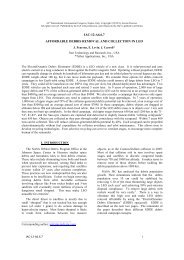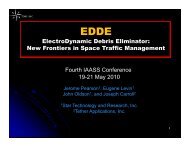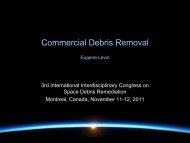The Cost of Future Collisions in LEO - Star Technology and Research
The Cost of Future Collisions in LEO - Star Technology and Research
The Cost of Future Collisions in LEO - Star Technology and Research
Create successful ePaper yourself
Turn your PDF publications into a flip-book with our unique Google optimized e-Paper software.
2<br />
Executive Summary<br />
As debris mitigation practices improve, catastrophic collisions <strong>in</strong>volv<strong>in</strong>g large debris<br />
objects can become the dom<strong>in</strong>ant source <strong>of</strong> debris pollution <strong>in</strong> low Earth orbits.<br />
<strong>The</strong>se collisions will produce hundreds <strong>of</strong> thous<strong>and</strong>s <strong>of</strong> debris fragments <strong>in</strong> the centimeter<br />
range (“shrapnel”) that are hard to track, but could be lethal to operational<br />
spacecraft.<br />
<strong>The</strong>re are non-trivial costs associated with catastrophic collisions <strong>and</strong> their<br />
consequences, some <strong>of</strong> them not immediately obvious. Our primary goal was to<br />
f<strong>in</strong>d a way to calculate the average statistically expected loss <strong>of</strong> assets after a catastrophic<br />
collision <strong>in</strong> a transparent <strong>and</strong> compact manner. We want it to be suitable<br />
for direct parametric analysis by decision makers, the space <strong>in</strong>surance <strong>in</strong>dustry, <strong>and</strong><br />
the scientific community alike.<br />
We did not rely on the exist<strong>in</strong>g fragmentation models, because they still need<br />
to be updated based on the latest on-orbit collision data. Instead, we used the two<br />
most relevant empirical data po<strong>in</strong>ts, the Fengyun-1C <strong>and</strong> Cosmos-Iridium events, to<br />
develop a high-level phenomenological model <strong>of</strong> production, distribution, <strong>and</strong> accumulation<br />
<strong>of</strong> small but lethal fragments <strong>in</strong> catastrophic collisions. <strong>The</strong> model is statistical<br />
<strong>and</strong> operates with mass distributions <strong>and</strong> virtual fluxes <strong>of</strong> debris fragments.<br />
It allows analytical evaluation <strong>of</strong> the statistically expected damage to operational<br />
satellites from future collisions <strong>in</strong> <strong>LEO</strong>.<br />
Us<strong>in</strong>g this model, we have found that the primary loss occurs not <strong>in</strong> the<br />
catastrophic collision itself, but with<strong>in</strong> a decade after the collision, when a piece <strong>of</strong><br />
untracked “shrapnel” produced <strong>in</strong> that collision hits a high value asset. It could be<br />
a “hidden” loss, because it may be hard to determ<strong>in</strong>e the true reason for the asset<br />
failure.<br />
We believe that the production <strong>of</strong> “shrapnel” <strong>and</strong> its long-term impact on the<br />
<strong>LEO</strong> environment are usually underestimated. <strong>The</strong> exist<strong>in</strong>g focus is biased toward<br />
trackable fragments over 10 cm. <strong>The</strong> average expected rate <strong>of</strong> production <strong>of</strong> lethal<br />
but untracked “shrapnel” will cont<strong>in</strong>ue to grow with new launches, <strong>and</strong> will rema<strong>in</strong><br />
substantial until wholesale removal is achieved. <strong>The</strong> fragment yield <strong>of</strong> an average<br />
catastrophic collision is likely to exceed the yield <strong>of</strong> the Fengyun-1C <strong>and</strong> Cosmos–<br />
Iridium events comb<strong>in</strong>ed. Removal <strong>of</strong> a few large debris objects per year would<br />
not reduce the rate <strong>and</strong> fragment yield <strong>of</strong> catastrophic collisions <strong>in</strong> <strong>LEO</strong> enough to<br />
prevent accumulation <strong>of</strong> “shrapnel” at altitudes above 800 km, where it will persist<br />
for a very long time.<br />
Our model clearly shows how different debris removal campaigns would affect<br />
average statistically expected production <strong>of</strong> “shrapnel” <strong>in</strong> <strong>LEO</strong> <strong>and</strong> why wholesale<br />
removal <strong>of</strong> large debris is necessary for restor<strong>in</strong>g the <strong>LEO</strong> environment.<br />
We also suggest that most “shrapnel” may be produced by “hypervelocity<br />
sprays” shredd<strong>in</strong>g those parts <strong>of</strong> collid<strong>in</strong>g objects that missed the direct impact.








